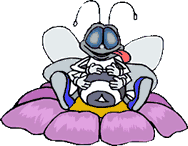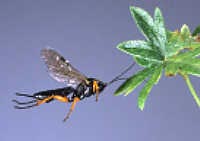|
In previous Eco-Logicals, we've talked about the problem of chemical pesticides around the house and yard. We don't want our kids and pets being exposed to these toxic substances. We've also talked about "adaptive pesticides," otherwise known as beneficial insects that prey on pest insects. This approach helps reduce or eliminate the need for toxic pesticides by providing natural pest control for your garden. Doing this also avoids the issue of pests developing resistance to pesticides since the beneficial insects evolve right along with the garden pests.
 Today's article will further explore the topic of natural pest control using beneficial insects and give specific tips about how you can add certain plants to your yard to create a haven for the good little buggers that can help you fight the bad little buggers. The information comes to us from the good folks at Eartheasy.com, a site that is chock-full of handy tips about how to live naturally and sustainably.
Today's article will further explore the topic of natural pest control using beneficial insects and give specific tips about how you can add certain plants to your yard to create a haven for the good little buggers that can help you fight the bad little buggers. The information comes to us from the good folks at Eartheasy.com, a site that is chock-full of handy tips about how to live naturally and sustainably.
~ ~ ~
Garden Insectary — Natural Pest Control
by Eartheasy.com
Creating A Home Base for Beneficial Insects
A garden insectary is a small garden plot of flowering plants designed to attract and harbor beneficial insects. These "good insects" prey on many common garden insect pests and offer the gardener a safer, natural alternative to pesticides.
The garden insectary is a form of "companion planting," based on the positive attributes plants can share in deterring pests, acquiring nutrients, or attracting natural predators. By becoming more diverse with your plantings, you're providing habitat,
 shelter, and alternative food sources (such as pollen and nectar), something many predators need as part of their diet.
shelter, and alternative food sources (such as pollen and nectar), something many predators need as part of their diet.
Here's an example. You can control aphids with an aphid predator like aphidius, and you can encourage aphidius to set up shop by planting sunflowers or lupin. Of course, the aphid predators need the pests to be present in order to eat, thrive, and reproduce—that is, they need aphids to be found in and around the general area you're trying to protect from the aphids. But that's where stocking your insectary with the appropriate plants comes in.
The idea of inviting the pests in to munch on plants in your insectary may seem alarming, until you understand that you are doing so to encourage host-specific pests. The pests remain on the desired plant in your insectary yet provide an ideal breeding ground for the associated predators and parasites.
Your insectary plot does not have to be large, just big enough to hold six to seven varieties of plants that attract insects. Once the garden has matured, you can watch your personal security force of beneficial insects do the work for you.
Natural Pest Control by Species
Use Table A to figure out which beneficial insects you want to attract, based on your particular pest problems. Then use Table B to see what you should plant to attract the beneficial insects (predator insects). Note that in Table A, pest species may occur in more than one row. Similarly, in Table B, predator species may be listed in more than one row. Find the combination of predators and insectary plants that maximizes the benefit to your particular pest problem.
Table A.
Natural Pest Control by Insect Species
| Aphids |
Aphidius |
| Aphids |
Aphidoletes |
| Thrips, spidermites, fungus gnats |
Beneficial mites |
| Eggs of many pest insects |
Damsel bugs (Nabidae) |
| Whiteflies, aphids, thrip, spider mites |
Dicyphus |
| Slugs, small caterpillars and grubs |
Ground beetles |
| Grubs |
Spring Tiphia wasp |
| Aphids, mealybugs and others |
Hoverflies |
| Scale, aphids, mites, soft-bodied insects |
Lacewings |
| Aphids, mites |
Ladybugs |
| Thrips, aphids, mites, scales, whiteflies |
Pirate bugs |
| Caterpillars; beetle and fly larvae |
Tachinid flies |
| Whiteflies; moth, beetle and fly larvae |
Parasitic wasps |
 |
| From left to right: ichneumon wasp, lacewing, pirate bug, hoverfly, damsel bug |
Table B.
What to Plant to Attract Beneficial Insects (Predator Insects)
| Lacewings, aphidius, ladybugs |
Achillea filipendulina |
| Hoverflies |
Alyssum |
| Ground beetles |
Amaranthus |
| Spring Tiphia wasp |
Peonies, firethorn, forsythia |
| Ichneumon wasp, ladybugs, lacewings |
Anethum graveolens (dill) |
| Lacewings |
Angelica gigas |
| Ladybugs, hoverflies |
Convolvulus minor |
| Hoverflies, parasitic wasps, lacewings |
Cosmos bipinnatus |
| Dicyphus |
Digitalis |
| Lacewings, ladybugs, hoverflies |
Daucus carota (Queen Anne's lace) |
| Damsel bugs, ladybugs, lacewings |
Foeniculum vulgare (fennel) |
| Pirate bugs, beneficial mites |
Helianthus annulus |
| Hoverflies |
Iberis umbellata |
| Hoverflies, parasitic wasps |
Limonium latifolium (Statice) |
| Aphidius, aphidoletes, hoverflies |
Lupin |
| Parasitic wasps, tachinid flies |
Melissa officinalis (lemon balm) |
| Parasitic wasps, hoverflies, tachinid flies |
Petroselinum crispum (parsley) |
| Pirate bugs, beneficial mites |
Shasta daisy |
| Pirate bugs, aphidius |
Sunflowers |
| Ladybugs, lacewings |
Tanacetum vulgare (tansy) |
| Dicyphus |
Verbascum thaspus |
 |
| From left to right: Statice, Lupin, Tansy, Queen Anne's Lace, Sunflower |
Get these two tables as a 1-page PDF file
Tips and Suggestions for Your Garden Insectary
1. Intersperse vegetable beds with rows or islands of insectary annuals.
This will add decorative elements to your vegetable beds while luring beneficial insects toward prey.
2. Allow some of your salad and cabbage crops to bloom.
Brassica flowers (cabbage, broccoli, Brussels sprouts, bok choy) are also appreciated.
3. Include plants of different heights in your insectary.
Ground beetles require the cover provided by low-growing plants such as thyme, rosemary, or mint. Lacewings lay their eggs in shady, protected areas, so providing such places near crop plants is a good idea.
4. Tiny flowers produced in large quantity are much more valuable than a single, large bloom.
Large, nectar-filled blooms actually can drown tiny parasitoid wasps.
5. Members of the Umbelliferae family are excellent insectary plants.
Fennel, angelica, coriander, dill, and wild carrot all produce the tiny flowers required by parasitoid wasps.
6. Composite flowers (daisy and chamomile) and mints (spearmint, peppermint, or catnip) will attract predatory wasps, hover flies, and robber flies.
Wrap-Up
A garden insectary should be thought of as a long-term permanent component of your garden. Results are not instant and conclusive; rather, the benefits to your garden are cumulative. As your plantings mature and resident populations of beneficial insects are established, the need for chemical pesticides and other aggressive insect control techniques will diminish. Your garden will become a more natural and balanced environment for the healthy production of vegetables and flowers.
Know a gardener who might find this article helpful?
Send them this article
| Eartheasy strives to help us reduce our impact on the earth's resources, bring more simplicity to our lives, spend less and enjoy more, and bring us closer to nature. Visit them at http://eartheasy.com/. |
|
Books:
Related articles:
MOM, CAN I PUT SOME SUPER-MORPHING BUG JUICE IN MY SQUIRT GUN?
We Can Fight Insecticide-Resistant Pests Better with Biological Controls
“HEALTH-B-GONE” AND OTHER HOMEOWNER PESTICIDE PROBLEMS
Is it Safe to Use Weedkillers and Bug Killers Where Kids and Pets Live?
More articles and resources on....
Get Grinning Planet free via email
|


